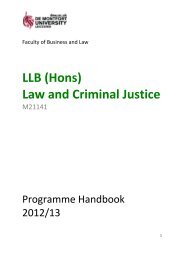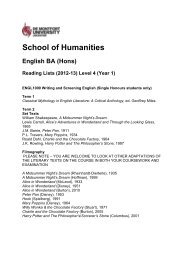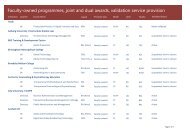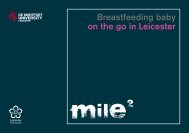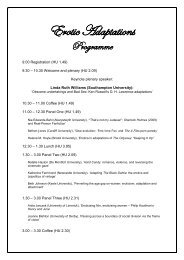Evaluation of the Crash Course March 2009 - De Montfort University
Evaluation of the Crash Course March 2009 - De Montfort University
Evaluation of the Crash Course March 2009 - De Montfort University
Create successful ePaper yourself
Turn your PDF publications into a flip-book with our unique Google optimized e-Paper software.
The research team devised a particular exercise to explore attitude differentials<br />
between <strong>the</strong> male and female groups on several issues using semantic differential<br />
scales. The descriptors for <strong>the</strong> extremes were discussed with <strong>the</strong> young people and<br />
in particular <strong>the</strong>y were comfortable with <strong>the</strong> term “cool” as meaning something<br />
acceptable to one’s peers and good for <strong>the</strong> self-image. The following graphs<br />
illustrate <strong>the</strong> means <strong>of</strong> <strong>the</strong> responses given in <strong>the</strong> focus group attitude scales for<br />
males and females. Figure 6.1 shows <strong>the</strong> results for <strong>the</strong> questions relating to driving<br />
at very fast speeds, and Figure 6.2 shows <strong>the</strong> results for attitudes towards driving<br />
whilst drunk. The focus groups were not randomly selected and cannot be deemed<br />
to be representative. Total numbers participating were small. These figures cannot<br />
<strong>the</strong>refore be seen as statistically valid but <strong>the</strong>y do give some insight into <strong>the</strong> attitude<br />
differences between <strong>the</strong> genders.<br />
Each graph shows a plot <strong>of</strong> <strong>the</strong> mean scores for each <strong>of</strong> <strong>the</strong> seven-point attitude<br />
scales. Scores are counted from <strong>the</strong> left hand <strong>of</strong> each scale, so for instance a score<br />
<strong>of</strong> 1 on <strong>the</strong> drunk driving safe/unsafe scale would represent a tick at <strong>the</strong> extreme<br />
“safe” end <strong>of</strong> <strong>the</strong> scale, and a score <strong>of</strong> 7 would represent one at <strong>the</strong> extreme “unsafe”<br />
end. In each case, <strong>the</strong> first term in <strong>the</strong> legend (e.g. safe, exciting, easy to ask to stop,<br />
etc.) for <strong>the</strong> bars represents <strong>the</strong> low end <strong>of</strong> <strong>the</strong> scales and <strong>the</strong> second term (e.g.<br />
unsafe, not exciting, difficult to ask to stop, etc.) represents <strong>the</strong> high end. Bars<br />
represent <strong>the</strong> means <strong>of</strong> all <strong>of</strong> scores given by both male and female focus group<br />
respondents.<br />
Figure 6.1: Differences between young men and young women in attitudes to<br />
speed<br />
4.00<br />
Mean 6.00<br />
2.00<br />
0.00<br />
Male<br />
Gender<br />
Female<br />
59<br />
Speeding safe/unsafe<br />
Speeding exicting/not<br />
exciting<br />
Easy/difficult to ask to<br />
slow down<br />
Cool/uncool to ask to slow<br />
down<br />
Likely/not likely to ask to<br />
slow down





